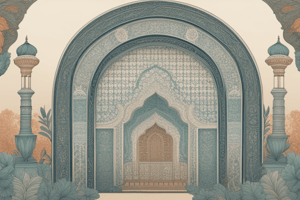Podcast
Questions and Answers
Who was one of the most notable leaders of the Indian National Congress?
Who was one of the most notable leaders of the Indian National Congress?
- Jawaharlal Nehru
- Rabindranath Tagore
- Indira Gandhi
- Mahatma Gandhi (correct)
What was the main objective of the Quit India Movement launched in 1942?
What was the main objective of the Quit India Movement launched in 1942?
- To gain provincial autonomy
- To fight for workers' rights
- To establish a separate Muslim nation
- To attain complete self-rule (correct)
What did the partition of India in 1947 divide British India along?
What did the partition of India in 1947 divide British India along?
- Ethnic lines
- Religious lines (correct)
- Linguistic lines
- Geographical lines
Which plan suggested a federal structure for India, leading to the decision for partition?
Which plan suggested a federal structure for India, leading to the decision for partition?
When did India gain independence from British rule?
When did India gain independence from British rule?
What was the primary cause of the Indian Rebellion of 1857?
What was the primary cause of the Indian Rebellion of 1857?
Which communities were involved in the Indian Rebellion of 1857?
Which communities were involved in the Indian Rebellion of 1857?
When was the Indian National Congress established?
When was the Indian National Congress established?
What was the main objective of the Indian National Congress?
What was the main objective of the Indian National Congress?
Which movement called for 'Quit India' in a bid for independence from British rule?
Which movement called for 'Quit India' in a bid for independence from British rule?
Flashcards
Indian Rebellion of 1857
Indian Rebellion of 1857
The first major uprising against British rule in India, sparked by religious conflict amongst Indian sepoys.
Indian National Congress (INC)
Indian National Congress (INC)
A political organization founded in 1885 to gain constitutional reforms peacefully.
Partition of India
Partition of India
The division of British India into India and Pakistan in 1947, based on religious lines.
Quit India Movement
Quit India Movement
Signup and view all the flashcards
Sepoy Mutiny
Sepoy Mutiny
Signup and view all the flashcards
Purna Swaraj
Purna Swaraj
Signup and view all the flashcards
Mahatma Gandhi
Mahatma Gandhi
Signup and view all the flashcards
Cabinet Mission Plan
Cabinet Mission Plan
Signup and view all the flashcards
Independence Day
Independence Day
Signup and view all the flashcards
British East India Company
British East India Company
Signup and view all the flashcards
Study Notes
Introduction
The Indian national movements refer to the various political efforts by Indians to gain independence from British rule. These movements were driven by a desire for self-governance, social reforms, and an end to the exploitative economic policies imposed by the British East India Company. Some key moments in these movements include the Indian Rebellion of 1857, the formation of the Indian National Congress, the partition of India, the Quit India Movement, and finally, India's independence.
Indian Rebellion of 1857
The Indian Rebellion of 1857 was the first major uprising against British rule in India. Also known as the Sepoy Mutiny, it began when sepoys (Indian soldiers employed by the East India Company) refused to use new rifle cartridges rumored to have been greased with cow and pig fat, which were considered religiously offensive to many Hindus and Muslims. The rebellion spread rapidly, leading to a widespread uprising across northern India involving both Hindu and Muslim communities. Despite being initially successful in some places, the rebellion ultimately failed due to lack of unity among rebels and the superior military power of the British.
Formation of the Indian National Congress
The Indian National Congress (INC) was established on December 28, 1885, at a meeting held in Bombay, with the primary objective of securing constitutional reforms through peaceful means. They advocated for equal rights and opportunities for all Indians regardless of caste or creed. Over time, the INC evolved into a powerful platform that demanded not just political freedom but also social changes. One of the most notable leaders of the INC was Mahatma Gandhi, who led several nonviolent civil resistance movements against the British colonial government, starting from 1919 until India gained independence in 1947.
Partition of India
The partition of India occurred in August 1947, dividing British India along religious lines into the Dominion of Pakistan (later divided into Pakistan and Bangladesh) and the Republic of India. The decision for partition came after the Cabinet Mission Plan of May 1946, which suggested a federal structure for India, did not gain acceptance due to widespread opposition, mainly from Muslim leaders seeking separate electorates and province-wise reservation of seats. The partition resulted in mass migrations, riots, and loss of life, leading to profound trauma and lasting consequences for both countries.
Quit India Movement
The Quit India Movement, launched on August 8, 1942, was a direct challenge to British authority in India. It aimed to force the British to leave India immediately, hence the name "Quit India". The movement saw mass protests throughout India, with major cities seeing violent clashes between demonstrators and police. Mahatma Gandhi issued a call to attain complete 'Purna Swaraj' (complete self-rule), declaring India free from foreign domination. Despite facing significant opposition and putting down the rebellion with brute force, the movement marked a turning point in India's freedom struggle.
Independence Movement
The Indian independence movement eventually led to the end of British rule in India. Following World War II, Britain became increasingly desperate to reduce its global commitments and expenses, leading to negotiations for constitutional reforms and eventual withdrawal from India. After years of political maneuvering and negotiations, India finally gained independence on August 15, 1947. This day has been commemorated annually since then as 'Independence Day'.
Studying That Suits You
Use AI to generate personalized quizzes and flashcards to suit your learning preferences.




